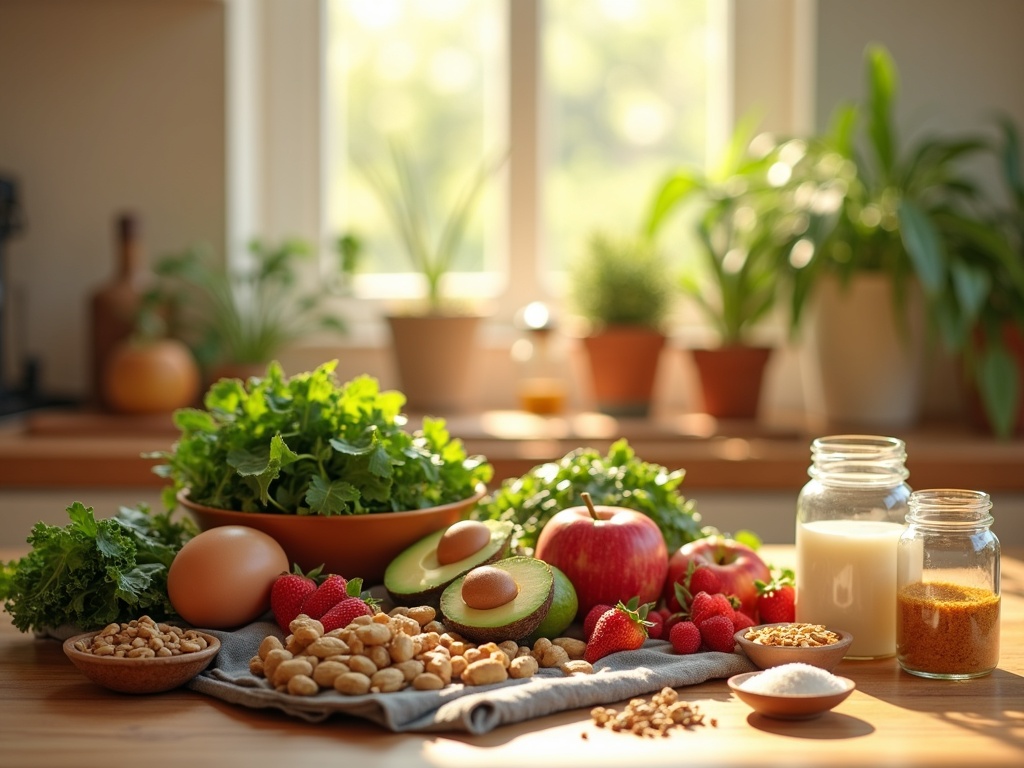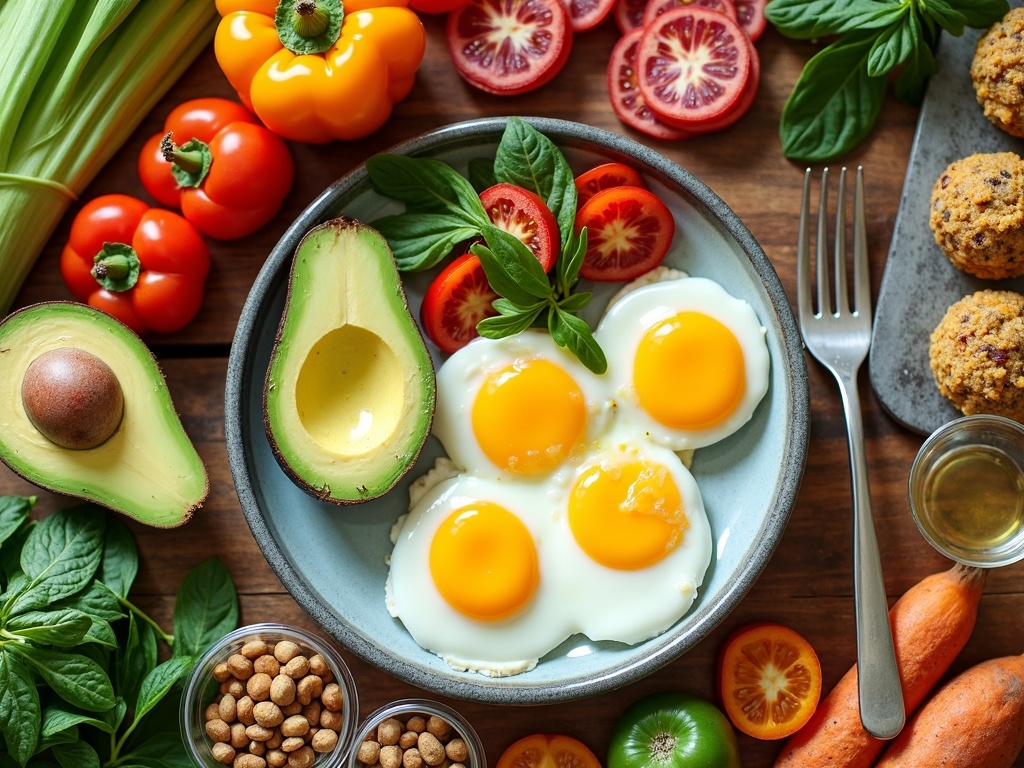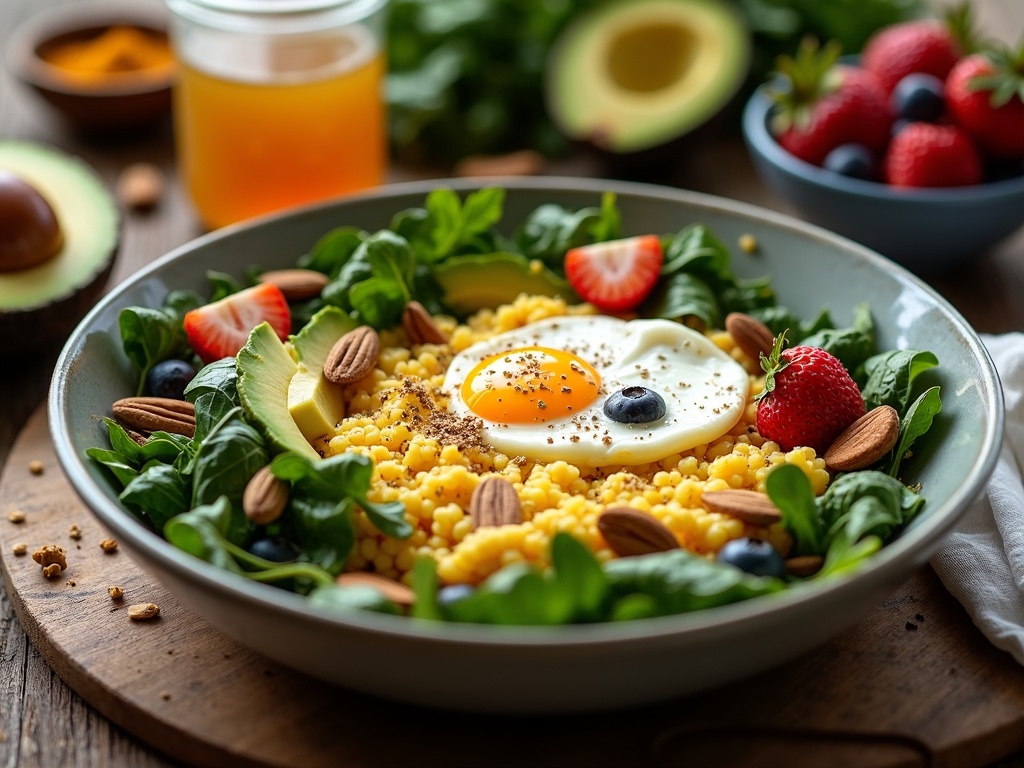The Paleo breakfast diet offers a nutritious breakfast approach centered on whole, unprocessed foods similar to what our ancestors ate. This diet cuts out grains, dairy, and refined sugars, replacing them with high-quality proteins, healthy fats, and fresh produce. Research indicates followers typically lose 5-10% of their weight within six months while experiencing better energy levels, improved digestion, and sharper mental clarity without the mid-morning energy crash common with standard carb-heavy breakfasts.
Find In This Article
Key Takeaways
- A Paleo breakfast emphasizes high-quality proteins (eggs, grass-fed meats), healthy fats (avocados, nuts), and fresh fruits and vegetables while eliminating grains and dairy.
- The nutrient-dense nature of Paleo breakfasts provides steady energy throughout the morning without blood sugar spikes and crashes.
- Common Paleo breakfast options include egg dishes with vegetables, sweet potato bowls, smoothies with collagen peptides, and chia puddings made with coconut milk.
- Meal prepping Paleo breakfasts like egg muffins or overnight chia puddings can make adherence easier during busy weekday mornings.
- Beyond weight management, Paleo breakfast foods contain antioxidants and anti-inflammatory compounds that support long-term health and optimal brain function.
Why the Paleo Diet Is Your Perfect Breakfast Solution
The Paleo diet has gained significant popularity in recent years, with approximately 3.1% of the US population following this ancestral eating pattern according to the USDA. I’ve found that breakfast is often the most challenging meal to adapt to Paleo guidelines, yet it’s arguably the most important for setting your day’s nutritional tone.
Embracing Paleo principles for your morning meal can yield impressive health benefits. Studies show followers experience 5-10% weight loss over six months, making it an effective approach for those looking to shed pounds while improving overall health markers.
What Makes Paleo Different
The Paleo diet focuses on natural, unprocessed foods similar to what our hunter-gatherer ancestors consumed. This approach eliminates grains, dairy, and refined sugars—ingredients that form the backbone of typical breakfast options like cereal, toast, and yogurt.
Instead, a healthy breakfast following Paleo principles emphasizes:
- High-quality proteins like eggs, grass-fed meats, and wild-caught fish
- Healthy fats from avocados, nuts, seeds, and olive oil
- Fresh fruits and vegetables
- Natural sweeteners like honey or maple syrup (in moderation)
This nutrient-dense approach provides steady energy throughout the morning, unlike the blood sugar rollercoaster that often follows carb-heavy conventional breakfasts.
Practical Benefits for Your Morning Routine
Starting your day with a Paleo breakfast has transformed my energy levels and helped me stay satisfied until lunch. The high protein content supports muscle maintenance, while healthy fats provide sustained energy without the mid-morning crash.
The grain-free, dairy-free nature of Paleo breakfast foods makes this approach particularly beneficial for those with food sensitivities. Many people report improved digestion and reduced inflammation after eliminating these potentially problematic food groups.
Creating easy healthy breakfast options within Paleo guidelines doesn’t have to be complicated. Simple combinations like scrambled eggs with vegetables and avocado can be prepared in minutes. For busier mornings, overnight chia puddings made with coconut milk offer convenient grab-and-go solutions.
The versatility of Paleo breakfast choices keeps meals interesting. From savory options like sweet potato hash with grass-fed ground beef to sweeter treats like grain-free pancakes made with almond flour, the possibilities extend far beyond typical breakfast fare.
For weekend family gatherings, breakfast casseroles using Paleo-approved ingredients create satisfying meals that even non-Paleo eaters enjoy. These dishes can incorporate seasonal vegetables and herbs for maximum flavor and nutritional value.
The mental clarity many experience on Paleo is another compelling reason to consider this approach for your morning meal. By avoiding blood sugar spikes and providing essential fatty acids, Paleo breakfasts support optimal brain function during your most productive hours.
Beyond weight management, the healthy breakfast foods emphasized in the Paleo diet contain antioxidants and anti-inflammatory compounds that support long-term health. The emphasis on whole, unprocessed foods naturally eliminates many additives, preservatives, and artificial ingredients found in conventional breakfast products.
I’ve found that adopting Paleo principles for breakfast creates a solid foundation for healthier eating choices throughout the day. When you start with nutrient-dense whole foods in the morning, you’re more likely to maintain similar standards for subsequent meals.
Essential Ingredients for Your Paleo Morning
Starting my day with a paleo breakfast has transformed my morning energy levels and overall health. The paleo diet focuses on whole, unprocessed foods that our ancestors would have eaten, and getting the right ingredients is crucial for a satisfying morning meal. I’ve found that stocking my kitchen with these essential paleo breakfast components makes healthy eating much easier.
Core Paleo Breakfast Ingredients
Eggs are the cornerstone of any nutritious breakfast plan, especially for paleo followers. I aim for 2-3 organic, free-range eggs per serving, which provide high-quality protein and healthy fats to fuel my morning. These nutrient powerhouses contain all nine essential amino acids and important brain-boosting nutrients like choline.
Leafy greens add vital micronutrients to my morning meals. I incorporate about 1 cup of spinach, kale, or arugula into my breakfast routine – whether sautéed with eggs or blended into a smoothie. These greens pack a serious nutritional punch without adding many calories.
Avocados have become my paleo breakfast secret weapon. Adding half to a whole avocado brings creamy texture and healthy monounsaturated fats that keep me full for hours. They’re also packed with potassium, fiber, and antioxidants that support overall health.
Nuts and seeds provide that essential crunch factor while delivering protein, fiber, and healthy fats. I sprinkle about 1/4 cup of mixed almonds, walnuts, chia seeds, or flaxseeds over my healthy breakfast bowls or blend them into smoothies for added texture and nutrition.
Fresh fruits bring natural sweetness to paleo breakfasts without refined sugars. I include about 1 cup of seasonal berries, apples, or other low-glycemic fruits to balance my morning meals while providing antioxidants and fiber. Berries work particularly well in paleo breakfasts due to their lower sugar content.
Quality fats are essential for the paleo lifestyle. I use 1-2 tablespoons of coconut oil or olive oil for cooking eggs or greens. These healthy fats not only add flavor but also help with the absorption of fat-soluble vitamins and provide long-lasting energy.
Herbs and spices elevate the flavor profile of breakfast foods without adding carbs or artificial ingredients. Sea salt, black pepper, and turmeric are my go-to seasonings. Turmeric, in particular, adds anti-inflammatory benefits to my morning meals.
I’ve found that having these ingredients ready in my kitchen makes throwing together a quick easy healthy breakfast much more doable, even on busy mornings. I can whip up everything from simple scrambled eggs with veggies to more elaborate breakfast bowls with just these basic components.
By focusing on these nutrient-dense ingredients, I create healthy breakfast foods that align perfectly with paleo principles while keeping my taste buds happy. The beauty of these ingredients is their versatility – they can be mixed and matched in countless ways to create meals that never get boring.
For meal prep convenience, I often combine several of these ingredients into make-ahead breakfast casseroles that can be portioned and reheated throughout the week. This strategy has been a game-changer for maintaining my paleo lifestyle without the daily cooking hassle.

Creating the Perfect Paleo Breakfast Bowl
A paleo breakfast bowl is one of my favorite ways to start the day with a nutrient-dense meal that’s both satisfying and simple to prepare. I’ve found that mastering this versatile dish gives me sustained energy throughout the morning while staying true to paleo principles.
Building Your Bowl Step-by-Step
The foundation of a great paleo breakfast bowl begins with quality ingredients and proper preparation. First, I heat a tablespoon of coconut oil in a skillet over medium heat until it shimmers. Coconut oil works beautifully for this nutritious breakfast option because it has a high smoke point and adds a subtle sweetness.
Next, I add a generous handful of leafy greens like spinach, kale, or Swiss chard. These need just 2-3 minutes to wilt down, creating a nutrient-rich bed for the rest of the ingredients. The greens add volume, fiber, and essential vitamins without adding many calories.
Once the greens have softened, I make room in the skillet for the eggs. Depending on my mood, I might scramble them directly in the pan or create wells in the greens to crack whole eggs for a sunny-side-up approach. The eggs take about 3-5 minutes to cook to perfection, and I always make sure the whites are set while keeping the yolks slightly runny for that creamy texture that coats the other ingredients.
Seasoning is crucial for a healthy breakfast with depth. I season with salt, freshly cracked black pepper, and a generous pinch of turmeric. The turmeric not only adds a warm, earthy flavor but also brings powerful anti-inflammatory benefits to start my day right.
The bowl really comes together with the toppings. I slice half an avocado and arrange it on top, then sprinkle a mixture of nuts and seeds for crunch. My favorite combinations include:
- Sliced almonds and pumpkin seeds
- Chopped walnuts and sunflower seeds
- Pecans and hemp hearts
- Brazil nuts and chia seeds
For a complete meal, I serve my breakfast bowl with a side of fresh fruit. Berries work particularly well with the breakfast foods in this bowl as they’re lower in sugar than many other fruits while offering antioxidants and flavor.
Nutritional Benefits of Your Paleo Bowl
The beauty of this easy healthy breakfast lies not just in its flavor but in its nutritional profile. The high protein content from the eggs supports muscle recovery and provides lasting energy. Each egg contains about 6-7 grams of complete protein, making this breakfast particularly valuable for active individuals.
The healthy fats from the coconut oil, avocado, and nuts/seeds aid tremendously in satiety, helping me stay full until lunch without cravings. These fats are also crucial for hormone production and brain health—giving me the mental clarity I need for productive mornings.
The combination of protein, healthy fats, and the fiber from vegetables and fruits creates a perfectly balanced healthy breakfast foods option that keeps blood sugar stable throughout the morning. This stability means no energy crashes around 10 AM that might have you reaching for a sugary snack.
I’ve found that preparing this breakfast casserole alternative takes just under 15 minutes from start to finish—quick enough for busy weekdays but special enough for weekend mornings. The versatility allows for endless variations while keeping within paleo guidelines, making it a sustainable breakfast choice that never gets boring.
Common Mistakes That Sabotage Your Paleo Breakfast
Starting your day with a paleo breakfast can set you up for sustained energy and better health outcomes, but several common mistakes might be undermining your efforts. I’ve noticed many people struggle with these issues, often without realizing how they impact the nutritional quality of their morning meal.
Ingredient Quality and Preparation Errors
Using non-organic ingredients is a frequent misstep that significantly reduces the nutrient quality of your paleo breakfast. Conventional produce often contains pesticide residues and typically has lower nutrient density compared to organic options. When I choose organic eggs, meats, and vegetables, I’m ensuring my body receives optimal nutrition without the chemical burden.
Another critical error is skipping essential healthy fats. The paleo approach embraces healthy fats as crucial energy sources. I’ve found that adding avocado, coconut oil, or grass-fed butter to breakfast recipes not only improves flavor but also promotes satiety and provides necessary fatty acids for brain function.
Many paleo enthusiasts inadvertently damage nutrients through overcooking. Eggs are particularly vulnerable—when yolks are fully hardened, valuable antioxidants and fat-soluble vitamins become less bioavailable. I prefer cooking methods that preserve the integrity of egg yolks, such as soft boiling or gentle frying in high-quality fats.
Including processed ingredients is perhaps the most obvious contradiction to paleo principles, yet packaging can be deceiving. Products labeled “natural” or “paleo-friendly” might still contain additives or preservatives. I always check ingredient lists thoroughly when shopping for breakfast foods, avoiding anything with unrecognizable components.
Planning and Variety Challenges
Not maintaining ingredient variety leads to nutritional gaps and meal fatigue. Many people fall into the routine of eating the same paleo breakfast daily—typically eggs with bacon. While convenient, this approach limits your nutrient intake. I make a point to rotate between different protein sources, seasonal vegetables, and various healthy breakfast foods throughout the week.
Poor meal prep planning often results in morning time crunches that lead to compromised food choices. Without preparation, it’s tempting to reach for convenient non-paleo options or skip breakfast altogether. Here are strategies I’ve found effective:
- Batch cook paleo breakfast staples like egg muffins or chia puddings on weekends
- Pre-chop vegetables and store them in glass containers for quick morning access
- Prepare freezer-friendly paleo breakfast options for busy mornings
- Create a weekly easy healthy breakfast menu to ensure variety and reduce decision fatigue
- Stock up on quality emergency options like nuts, seeds, and compliant protein powders
Another mistake is neglecting to adapt your breakfast to your specific needs. The paleo framework allows flexibility, and your morning meal should reflect your activity level and personal health goals. When I plan an intense workout, I include more carbohydrates from sweet potatoes or fruit in my healthy breakfast.
Many people also struggle with portion control, either eating too little to sustain morning energy or consuming excess that leads to midday crashes. I’ve learned to tune into hunger signals while ensuring my breakfast includes adequate protein, healthy fats, and fiber-rich vegetables or fruits.
Lastly, I’ve seen many paleo beginners create elaborate breakfast casseroles daily, leading to burnout. Balance is key—I reserve complex preparations for weekends and rely on simple, nutritious combinations for busy weekdays. This sustainable approach helps maintain paleo breakfast compliance long-term while avoiding the perfectionism that often leads to abandoning beneficial dietary changes altogether.

Delicious Paleo Breakfast Variations
Starting my day with a nutritious paleo breakfast keeps me energized and focused throughout the morning. I’ve discovered several delicious variations that maintain strict paleo guidelines while offering plenty of flavor and convenience.
Satisfying Paleo Morning Options
Sweet potato breakfast bowls have become my go-to morning meal. I dice and roast sweet potatoes with coconut oil and cinnamon, then top them with sliced bananas, a sprinkle of chopped nuts, and a drizzle of almond butter. This hearty breakfast option provides complex carbohydrates that release energy slowly throughout the morning.
Nutrient-rich smoothies make for quick yet satisfying paleo breakfasts. I blend frozen berries, a banana, a handful of spinach, almond milk, and a scoop of collagen peptides for added protein. These nutrient-packed breakfast drinks take just minutes to prepare but deliver hours of sustained energy.
Egg muffins loaded with vegetables have saved me on busy mornings. I mix beaten eggs with chopped bell peppers, spinach, mushrooms, and a pinch of herbs, then bake them in a muffin tin. These protein-rich breakfast foods can be made ahead and refrigerated for up to four days.
Overnight chia seed pudding offers a no-cook breakfast option that’s ready when I wake up. I mix chia seeds with coconut milk, vanilla extract, and a touch of honey, then refrigerate overnight. By morning, the mixture transforms into a creamy pudding that I top with fresh berries and toasted coconut flakes for a nutritious breakfast treat.
These paleo breakfast variations work perfectly for meal prep. I often prepare several options on Sunday evening to ensure I have quick healthy breakfasts available throughout the week. The egg muffins and chia pudding can be stored in glass containers, while sweet potato bowls can be partially prepped by roasting the potatoes in advance.
Each of these options follows strict paleo guidelines by excluding grains, dairy, legumes, and processed foods. Instead, they focus on whole, nutrient-dense ingredients that our ancestors might have eaten. This approach to breakfast helps maintain stable blood sugar levels and provides lasting energy without the mid-morning crash often associated with grain-based breakfasts.
By incorporating these versatile breakfast recipes into my routine, I’ve found that paleo eating can be both convenient and delicious, even on the busiest mornings.
Sources:
American Journal of Clinical Nutrition
USDA Dietary Guidelines reports
The Paleo Diet book by Loren Cordain

